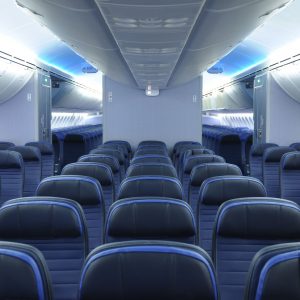 Aircraft cabins are a key focus as the air travel industry looks to ensure safe and profitable operation in the wake of COVID-19. Passengers and crew need to feel confident that sharing these spaces is safe. Meanwhile, airlines must be able to adhere to safety measures, like social distancing, while carrying enough passengers to support the industry’s recovery. Original equipment manufacturers (OEMs) are combining incremental improvements with longer-term innovation to support a safe and resilient industry.
Aircraft cabins are a key focus as the air travel industry looks to ensure safe and profitable operation in the wake of COVID-19. Passengers and crew need to feel confident that sharing these spaces is safe. Meanwhile, airlines must be able to adhere to safety measures, like social distancing, while carrying enough passengers to support the industry’s recovery. Original equipment manufacturers (OEMs) are combining incremental improvements with longer-term innovation to support a safe and resilient industry.
Reimagining aircraft interiors
In recent years, innovative OEMs have been reimagining traditional cabin layouts to maximize space and enhance the passenger experience. Using advanced simulation and collaboration technology has empowered them to experiment, perfect and test their designs efficiently, without having to build multiple physical prototypes. And as full order books led to long production backlogs, they’ve also been able to tweak those designs as new regulations emerged or customer priorities changed.
 COVID-19 has added new dimensions to the challenge. For example, how can the design and arrangement of seating effectively combat virus spread while comfortably accommodating enough passengers for profitable operation? Where and how can screens be used in a way that protects, but doesn’t intrude? And importantly, how does the cabin interior inspire confidence in potential passengers? Using the same simulation technologies, OEMs can answer those questions and demonstrate their designs to stakeholders.
COVID-19 has added new dimensions to the challenge. For example, how can the design and arrangement of seating effectively combat virus spread while comfortably accommodating enough passengers for profitable operation? Where and how can screens be used in a way that protects, but doesn’t intrude? And importantly, how does the cabin interior inspire confidence in potential passengers? Using the same simulation technologies, OEMs can answer those questions and demonstrate their designs to stakeholders.
Evaluating air flow
Clean air is essential in the confined space of an aircraft cabin. Leading OEMs like Airbus and Boeing, for instance, use systems that continuously monitor air flow, pressure, temperature and quality, filtering out more than 99% of particles, including bacteria and viruses, and renewing the air completely every three minutes. The two companies are also working with academics, health experts and learning institutions to research the behavior of COVID-19 onboard planes, using computer models to simulate the cabin environment.
Advanced simulation technology enables OEMs to model air flow and potential virus dispersal in the context of the cabin design. This allows them to see how different materials, seating arrangements and equipment, like screens or face masks, could affect the spread of a virus, and to evaluate the most effective direction for air filtration – from the top of the cabin to the bottom, for instance, or from one side to the other.
Ensuring safe surfaces
Touchless experiences and advanced sanitizing capabilities are two key areas where modeling the behavior of designs, materials and microbes is enabling continuous innovation in cabin hygiene. Development and testing of antimicrobial materials and coatings, for instance, can enable innovative new ways to prevent the spread of infection through seating and other furnishings. The design of cabin furniture can also be optimized so it’s easy to clean and disinfect.
New technologies being evaluated by Boeing include ultraviolet light disinfecting systems and antimicrobial coatings, which could eliminate virus particles from high-touch surfaces. Meanwhile, passengers and crew will have no need to touch some surfaces at all. Touchless faucets and flushes are already familiar in cabin lavatories, and new developments including gesture-operated stowage compartments and in-flight entertainment user interfaces operated by eye movement are expected to appear in the future.
Discover how Dassault Systèmes can help you create the cabin of the future.
This post by David Ziegler originally appeared in The 3D Perspectives Blog.
